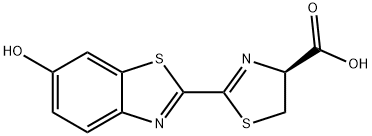Detail
Basic information
Chemical name: 4,5-dihydro-2-(6-hydroxy-2-benzothiazolyl)-4-thiazole-carboxylic acid
MF: C11H8N2O3S2
MW: 280.32
Physical & Chemical Properties
Melting point 200-204 °C
alpha D22 -36° (c = 1.2 in DMF)
Boiling point 587.6±60.0 °C(Predicted)
density 1.4916 (rough estimate)
refractive index 1.5650 (estimate)
storage temp. -20°C
solubility DMF:30.0(Max Conc. mg/mL);107.02(Max Conc. mM)
DMSO:35.33(Max Conc. mg/mL);126.05(Max Conc. mM)
form Powder
pka 8.31±0.40(Predicted)
color Off-white to light yellow
λmax 360nm(H2O)(lit.)
Application/Usage
D-Fluorescein is a substrate that relies on adenosine triphosphate (ATP) bioluminescence reactions. The bioluminescence reaction of luciferin/luciferase is commonly used for the detection of ATP, metabolites that can be converted to ATP (such as AMP, ADP, cAMP), and enzymes that can produce ATP (such as creatine kinase). Therefore, the bioluminescence reaction of luciferin/luciferase can be applied to the detection of a wide range of biomaterials. Bioactive D-Luciferin (Fireflyluciferin) is a popular substrate for bioluminescence in the presence of ATP, used for luciferase based bioluminescence imaging and high-throughput screening based on cells.
Specifications:98%
Use:

